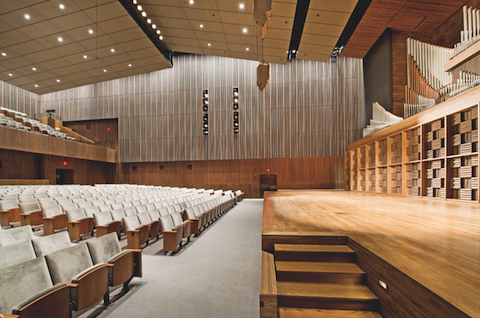Gartner Auditorium was originally designed by Marcel Breuer and completed, in 1971, as part of his Education Wing at the Cleveland Museum of Art. Despite that lofty provenance, the Gartner was never a perfect music venue—“a problem child,” music critic Donald Rosenberg called it.
In 2005, as part of a $350 million expansion and renovation of its facilities, the museum closed the Gartner in anticipation of a major renovation that would bring the auditorium into the 21st century in terms of technology, performance capability, and community outreach and education.
Four years later, a Building Team led by Cleveland architecture firm Westlake Reed Leskosky and CM at risk Donley’s took on the project.
The chief concern was the sidewalls, a large expanse of heavy wood grillework that was used to conceal acoustical drapery but which itself caused acoustic problems right from the start. Plywood was installed behind the grilles as a partial remedy, but the plywood impinged on the ability of the drapery cavity to adjust the acoustics.
The team, led by acoustician Akustiks LLC, South Norwalk, Conn., installed new sidewall paneling consisting of metal frames, wood battens, and theatrical scrim to replace the original wood grilles and acoustic draperies. The new panels are acoustically transparent while being visually opaque. The cavity beyond the sidewalls panels includes faceted MDF fiberboard, horizontal concrete shelves, and motorized acoustic curtains that can be adjusted to fit the type of performance in the space.
The original mechanical systems were located directly adjacent to the balcony level of the auditorium, allowing the noise from the systems to penetrate into the auditorium. The Building Team upgraded the HVAC system to achieve a four-fold decrease in noise levels, making the Gartner much more conducive to recording than in the past.
The ceiling plane was fitted with perforated metal that is essentially sound transparent. Two curving plywood acoustical canopies were strategically placed to project sound out to the audience.
The Gartner reopened last February and now hosts films, lectures, dance, and chamber music performances. The renovation has made the auditorium “lighter, friendlier, and more intimate,” said Rosenberg.
“They integrated a lot of new technology, but the space still feels very original,” said David Callan, PE, Environmental Systems Design, Chicago. “Very sophisticated,” said Walker Johnson, FAIA, Johnson Lasky Architects, Chicago. BD+C
PROJECT SUMMARY
Building Team
Owner: Cleveland Museum of Art
Owner’s representative: The Rise Group, LLC
Submitting firm: Westlake Reed Leskosky (architect/theater consultant/SE)
MEP engineer: Karpinski Engineering
Construction manager: Donley’s
Acoustician: Akustiks, LLC
Lighting consultant: George Sexton Associates
Audio-visual systems: Scharff Weisberg
General Information
Area: 10,200 gsf
Construction cost: $5.1 million
Construction time: March 2009 to February 2010
Delivery method: CM at risk







